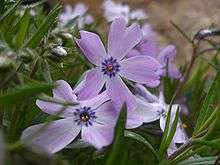| Phlox | |
|---|---|
 | |
| Genus: | Phlox |
| Family: | Polemoniaceae |
| Pollination: | Insects |
Phlox (pronounced "flocks") is a genus of 67 species of annual or perennial flowering plants. Some species flower in early spring while others flower in summer into fall. Most species are native to temperate North America but a few species are also from northeastern Asia. They are found growing in diverse habitats from alpine locations to open woodlands and prairies.
Description
Phlox range in color from pale blue to bright red to white, though cultivars have been bred for purple and deep blue. Some species such as Phlox glaberrima (Smooth Phlox) grow to 1.5 m tall, while others, such as Phlox stolonifera (Creeping Phlox), form low mats only a few centimeters in height. Seeds are in a 3-celled, valved capsule, with one seed to each cell.
The flowers are 5-lobed, with a tube below the lobes. The flower buds open by untwisting.
Growing conditions
Phlox is best grown in fertile, well-drained soil, exposed to partial shade to partial sun.
Species
- Phlox adsurgens - Northern Phlox
- Phlox alyssifolia
- Phlox andicola
- Phlox austromontana
- Phlox bifida - Sand Phlox
- Phlox borealis
- Phlox bryoides
- Phlox buckleyi - Swordleaf Phlox
- Phlox caespitosa - Cushion Phlox
- Phlox carolina - Thickleaf Phlox
- Phlox cuspidata - Pointed Phlox
- Phlox diffusa - Spreading Phlox
- Phlox divaricata - Blue Phlox or Woodland Phlox
- Phlox douglasii
- Phlox drummondii - Drummond Phlox
- Phlox floridana - Florida Phlox
- Phlox glaberrima - Smooth Phlox
- Phlox idahonis - Idaho Phlox
- Phlox kelseyi - Kelsey's Phlox
- Phlox maculata - Meadow Phlox
- Phlox missoulensis - Missoula Phlox
- Phlox multiflora - Flowery Phlox, Rocky Mountain Phlox
- Phlox nana - Santa Fe Phlox

- Phlox nivalis - Trailing Phlox
- Phlox ovata - Mountain Phlox
- Phlox paniculata - Summer Phlox
- Phlox pilosa - Prairie Phlox
- Phlox pulchra - Alabama Phlox
- Phlox sibirica - Siberian Phlox
- Phlox speciosa - Bush Phlox
- Phlox stolonifera - Creeping Phlox
- Phlox subulata - Moss Phlox
Uses
Phloxes are grown for their showy, often fragrant flowers in borders and cutting gardens. They attract both butterflies and hummingbirds.
Maintenance
Deadheading and staking are often needed for taller species.
Propagation
Division, cuttings, or seed.
Pests and diseases
Crown Gall
- Agrobacterium tumeifaciens
- Erisiphe chicoracearum
- Sphaerotheca humili
- Ascochyta phlogis var. pholgina
- Cercospora omphakodes
- Cercospora phlogina
- Macrophoma cylindrospora
- Phyllosticta sp.
- Ramularia sp.
- Septoria divaricata
- Stemphylium botryosum
- Pyrenochaeta phlogina
- Sclerotinia
Crown Rots
- Pellicularia rolfsii
- Sclerotium delphinii
- Thielavopsis basicola
- Verticillium albo-atrum
- Puccinia douglassii
- Uromyces acuminatus var. polemonii
Viri
- Mosaic
Phytoplasma
- Aster Yellows
- Stem Canker by Ditylenchus dispaci
Aphids Scales
- Black Scale: Saissetia oleae
- Aster Leaf Hopper: Macrosteles facifrons
- Phlox Plant Bug: Lopidea davisi
- Fourlined Plant Bug: Poecilocapsus lineatus
- Tarnished Plant Bug: Lygus lineolaris
- Japanese Beelte: Popillia japonica
- Asiatic Garden Beetle: Maladerma castanea
- Black Blister Beetle: Epicuata pennsylvanica
- Golden Tortoise Beetle: Chadidotella bicolor
- June Beetles: Phyllophaga spp.
- Oriental Beetle: Exomala orientalis
- Potato Flea Beetle: Epitrix cucumeris
- Black Vine Weevil: Otiorhynchus sulcatus
- Corn Earworm: Heliothis zea
- Saddleback Caterpillar: Sibine stimulea
- Stalk Borer: Papaipema nebris
- Twospotted Spider Mite: Tetranychus urticae
The foliage of Phlox is sometimes eaten by the larvae of some Lepidoptera species including Dot Moth, Gazoryctra wielgusi, w:Hummingbird Hawk-moth and Schinia indiana which feeds exclusively on P. pilosa. Phlox species are also a popular food source for groundhogs, rabbits and deer.
References
- Ann Fowler Rhoads and Timothy A. Block (2000). The Plants of Pennsylvania: An Illustrated Manual. Anna Anisko, illustrator. Morris Arboretum, University of Pennsylvania Press. pp. 538-539.
- P. D. Strausbaugh and Earl L. Core (1977). Flora of West Virginia (Second ed.). Seneca Books, Grantsville, W. Virginia. pp. 768-772.
- Christopher Brickell and Judith D. Zuk (1997). The American Horticultural Society A-Z Encyclopedia of Garden Plants. DK Publishing. pp. 785-787.
- Staff of the L. H. Bailey Hortorium (1976). Hortus Third: A Concise Dictionary of Plants Cultivated in the United States and Canada. Cornell University Press. pp. 681-682.
- Pirone, Pascal P. (1978). Diseases & Pests of Ornamental Plants (Fifth Edition ed.). John Wiley & Sons, New York. pp. 401-403.
- Cranshaw, Whitney (2004). Garden Insects of North America: The Ultimate Guide to Backyard Bugs. Princeton University Press. pp. 611.
- Pippa Greenwood, Andrew Halstead, A.R. Chase, Daniel Gilrein (2000). American Horticultural Society Pests & Diseases: The Complete Guide to Preventing, Identifying, and Treating Plant Problems (First Edition ed.). Dorling Kindersley (DK) Publishing, inc.. pp. 198.